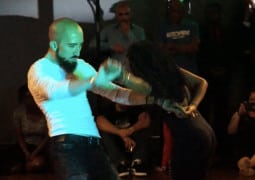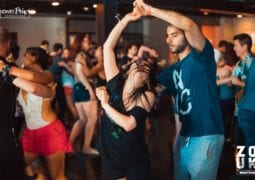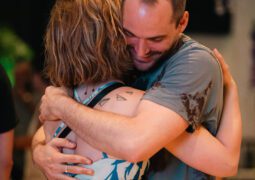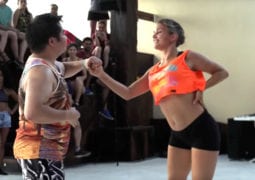Dancing with 100 Partners at the Same Time
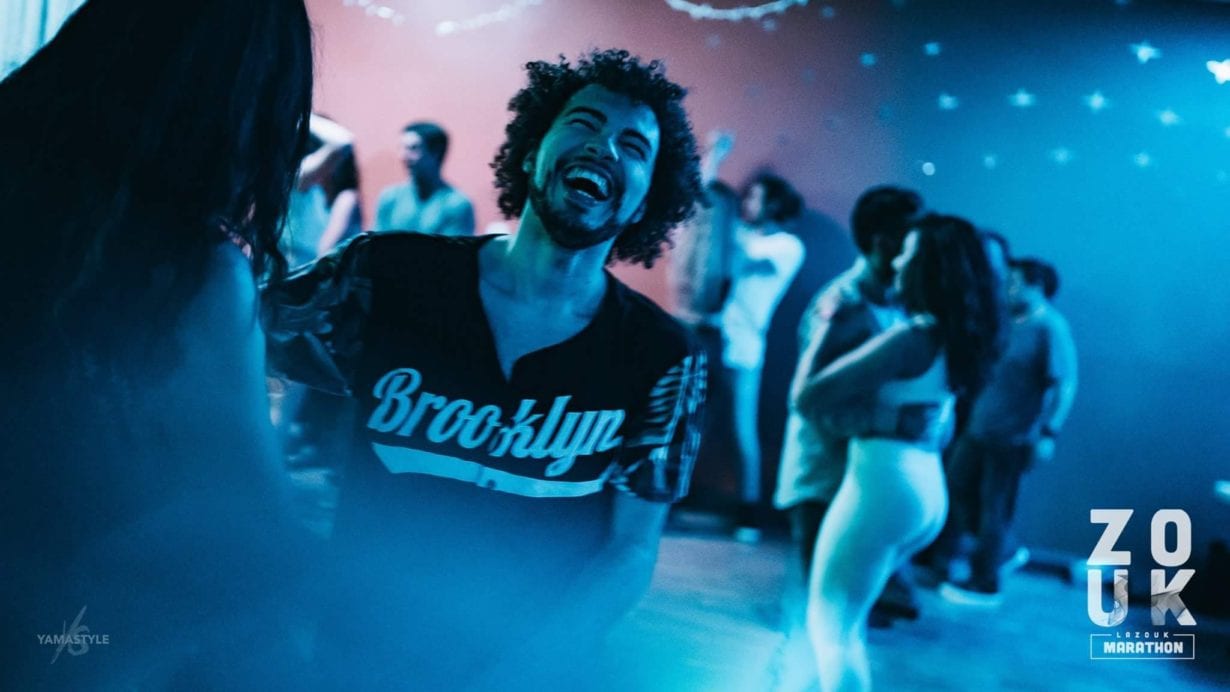
My name is Tom Lev (AKA DJ Fro-Yo), and I found a way to dance with (at least) 50 partners at once, even 100. In this article I shall explain the unique techniques to do so.
How does it work?
Most partner dance styles are limited to 1 lead and 1 follow. In some settings— 1 lead and multiple follows (somebody said Lamba-tres?) or multiple leads and 1 follow (often seen in Zouk socials). But even in those we are not dancing with everyone at once— every person is limited by their turn leading/following, then spends time observing the others do it.
Well, the headline wasn’t a joke, but I haven’t invented a crazy new telepathic dance (Tele-Lamba?), even though it would have been a much cooler topic to write about.
In this article I’ll be talking about being a DJ.
I connect to my partners (the crowd) and express myself through the music, I listen to their body respond and let them express their own musicality, and finally – I adjust my energy, from high to low and vice-versa, according to my partners.
When I DJ, I dance – both lead and follow – with the entire room at once.
“Well, you’re just playing a few songs with a loud speaker, what’s all this talk about dancing?”
And away we go:
What is a DJ?
The original term is “Disc Jockey”, the “Disc” part referring to vinyl records. We are way past that, but the principle remains the same— the DJ mixes and plays recorded music to a live audience. Some DJ’s also producers, and create music.
I won’t copy the whole definition from Wikipedia, but here’s the important bit (to my opinion):
“…DJs use audio equipment that can play at least two sources of recorded music simultaneously and mix them together to create seamless transitions between recordings and develop unique mixes of songs.”
As a DJ, I am to choose and mix songs together, and transition in a way that does not disrupt the continuity of the party’s energy. I have to flow to the next song seamlessly, whether it has a similar energy to the last song or a different one.
What is Dance?
Many definitions are out there, but a short and a favorite one is:
“Dance is human movement created and expressed for an aesthetic purpose”
Umm…Aesthetic? Here’s a short and favorite definition of that as well:
“relating to, involving, or concerned with pure emotion and sensation as opposed to pure intellectuality”.
Of course, aesthetic regards to beauty, but beauty (particularly in dance) is comprised of more than external features.
Dance is creating movement, expressing pure emotion.
Even with the most beautiful and technical dancers, it seems like something is missing if there’s no emotion to their dance. Once you’ve seen the emotional dancer you understand what is missing – without emotion, it’s lifeless.
In social partner dancing— not performances— the focus is less on the external beauty of the dance, it’s the sensation and emotion expressed and created between connected partners.
“I thought we were talking about being a DJ…? What’s all this about dance?”
As a DJ, I choose songs and transition between them. My song choices and transitions are not random – it is the way I express myself, or more accurately my emotions. I’m telling a story.
Good stories are ones that you get lost in, and that is my goal – to have people connect and be a part of that story, getting lost in it.
The way for me to create a story the crowd likes and gets lost in, is to…let the crowd co-create it.
That’s right – I don’t pre-plan or pre-select my songs by order, because I have no idea what story would be appropriate.
What better way to understand what my crowd wants to hear than to ask it?
My conversation with the crowd is what keeps me going. This is how it goes:
I play a song, offering a narrative for our story. Those moments are always super exciting, because as it plays, I can see the movement in the crowd change. “Do they like it?”, I ask myself. I feel an energy shift in the room – as weird as it may sound – it really is in the air, and I feel if the crowd embraces this storyline or prefers another. From there, I go on to pick the next song, adjusting to what I feel, and again feel the crowd react.
Seeing the energy going up, hearing someone scream in joy after a transition, or even feeling this incredible sense of unity when the crowd and I match the energy – give me an incredible rush, and I get lost too, in our story.
So with my music, I create movement, expressing pure emotion – that sounds a lot like dance to me!
Being a DJ is just like social dancing for me – I can’t just go on my own, leaving my follow behind completely disconnected and feeling misunderstood.
I’m leading the crowd, small as 10 or as big as 100 people, by the choice of music and my transitions, and as a lead I aim to be as soft and as clear as I can, without sharply pulling them through some move that I like or losing the trust of my follows.
I listen to my follows to make sure our intentions aren’t conflicting, to avoid taking them where they can’t or won’t go (such as fast music for beginners, high energy music for mellow end of the night vibes, etc.)
When I DJ, I dance – both lead and follow – with the entire room at once.
“OK, but how can you know what the crowd would want? Possibilities are pretty much endless!”
I have no idea what will happen when I DJ, just like when I approach a dance partner:
“What moves will I execute? How close will the embrace be? What is he/she feeling?”
We never know the answer, but we can prepare. We can have an extensive, in-depth knowledge of moves and techniques, to be able to maneuver freely and adjust quickly.
I learned my technique and basics in-depth. I constantly pick the best songs that I can find to renew my reservoir, and I take my time experimenting and practicing for many hours, to be ready for quick changes, keeping the mix seamless.
“If being a DJ is like dancing, don’t you have bad dances/DJ sets?”
This is one hard truth that every artist, no matter the area, learns:
You can NEVER please 100% of the crowd.
When you express yourself to a group of people, there will be ones who aren’t pleased. Even when you try to match the crowd (as DJ or dancer) – it is inevitable, and the reasons are many:
Sometimes your taste is just different, the energy difference is too great, or you just read them wrong. That does not mean I don’t aspire to create the best experience possible.
My solution was changing my goals – I aim to please the majority of the crowd and myself (important too!), be the best I can be at the present moment and avoid technical mistakes that can be prevented – so failures would (hopefully) be only those that there’s nothing I can do about.
I’ll finish with one of my favorite quotes:
“When truths about one art form are deep enough, they become true about all art.” -Sanford Meisner
The truth about social dance is that we have to be open to any influence. If we are stiff minded and barricaded with internal thoughts and conflicts, we are not responsive and flexible. We as dancers have to be neutral and let the emotions, the music, and the partner affect us.
It is true about the art of dancing, and it’s certainly true about the art of DJing.
You may also like...
Sorry - Comments are closed



